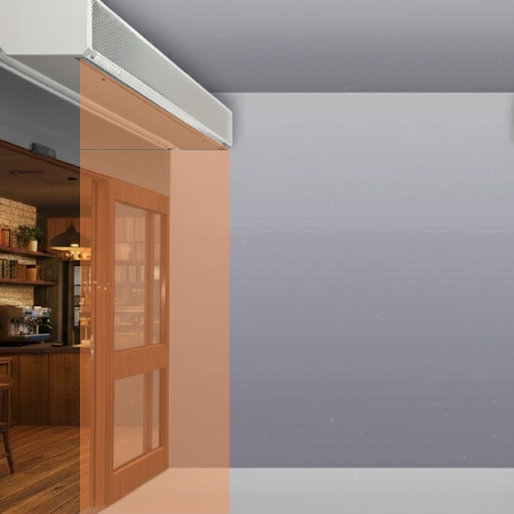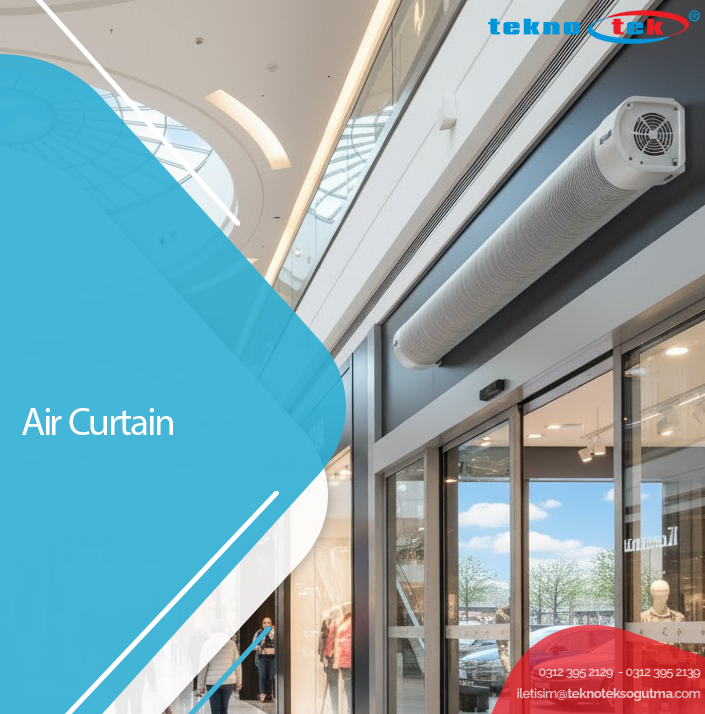Air curtain is a system used to prevent hot or cold air from entering an indoor environment. This system is frequently preferred in areas with constant entry and exit, such as stores, factories, hotels, and hospitals. The device, which creates an invisible air barrier above the door, prevents dust, exhaust gases, insects, or unpleasant odors from entering from the outside. In this way, it maintains the indoor climate balance while helping to achieve energy savings.
Air curtain is a system that helps air conditioning systems operate more efficiently. This system is used in both summer and winter. During winter, it prevents the warm air from escaping, and in summer, it prevents the loss of cool air. In this respect, this device, which reduces energy costs in businesses, also contributes to maintaining hygiene standards. Today, these curtains, supported by automatic sensor systems, have become indispensable, especially in modern buildings.
What is an Air Curtain?
It is used to separate the interior and exterior environments at door openings. Modern systems create a strong airflow and prevent the warm or cool air inside from escaping. In this field, Freedoor air curtain models stand out for their technical features and adaptability to different types of spaces. The use of these curtains is common at store entrances, hotel lobbies, restaurants, and production facilities where there is heavy foot traffic.
The use of these devices also provides protection against dust, exhaust fumes, insects, or unpleasant odors caused by external factors. Thus, while the hygiene level of the indoor environment increases, the efficiency of the air conditioning systems is also maintained.
For the door-mounted air curtain system to work effectively, the size of the area where it will be used must be measured. Accordingly, attention should be paid to selecting the appropriate model.
These devices operate in connection with the heating and cooling systems of the environment and contribute to energy efficiency. Choosing the right curtain according to the application area helps maintain a comfortable climate balance at door entrances. This, in the long run, reduces business expenses.
Types of air curtains include:
• Standard air curtains
• Heated air curtains
• Industrial air curtains
• Decorative air curtains
• Sensor-controlled air curtains
Air curtain systems are among the essential solutions for modern structures in terms of comfort and energy efficiency.
Air Curtain Prices
There are several factors that affect air curtain prices. These include the device’s technical capacity, dimensions, application area, and energy type. All these elements may cause variations in pricing.
Other factors that influence the price include door height, air velocity, and motor power. These aspects may cause prices to increase. Compact models used for small stores or office entrances are generally more affordable, while industrial types used in high-ceilinged spaces are more powerful and thus come at a higher cost range. In addition, whether the device is heated or non-heated has a direct impact on the total cost.
Used as a door-mounted system at entrances, these devices enhance indoor comfort while reducing long-term operating expenses through energy savings. Other factors determining prices include the motor technology used, air outlet direction, noise level, and body material.
Air curtain products are available at various price ranges:
• Standard models meet basic air conditioning needs.
• Heated models are preferred in cold climates.
• Industrial models are used in large door openings and high-traffic areas.
• Decorative and sensor-controlled models offer aesthetic design and automatic control advantages.
Heated Air Curtain
A heated air curtain is an effective system used in winter to maintain indoor temperature and block cold air entering through doorways. These devices create a strong warm airflow at entrances, thereby improving comfort while preventing energy loss. They are generally used in shopping malls, hotels, hospitals, and offices with heavy traffic.
The heated air curtain keeps the interior temperature stable and blocks cold drafts from outside, creating a comfortable atmosphere for employees and customers. These models are energy-efficient and reduce heating costs for businesses.
The non-heated air curtain, on the other hand, only creates an air barrier. It is used during the summer months to prevent cool indoor air from escaping. Both models are manufactured in different sizes depending on door height, air volume, and application area. Choosing the right model helps maintain air balance and ensures long-lasting system performance.
Cold Air Curtain
A cold air curtain is used in the summer to prevent the cool indoor air from escaping and to block the entry of hot air from outside. This system creates a strong air stream at door entrances and forms an invisible barrier between the indoor and outdoor environments. As a result, it helps preserve coolness and contributes to improved energy efficiency.
Air curtains are frequently used not only in hot climates but also in markets, restaurants, hotels, and shopping malls with heavy human traffic. Cold air curtains support the performance of air conditioning systems, allowing them to operate with less energy consumption. Moreover, they help maintain indoor hygiene by blocking external elements such as dust, exhaust, and humid air.
Modern cold air curtain models today offer quiet operation, remote control functionality, and sensor-based automatic activation systems, ensuring convenient and comfortable use.

What is the Purpose of an Air Curtain?
An air curtain is a comprehensive device that enhances energy efficiency while providing indoor comfort. These devices are installed at doorways or passage points and create a strong stream of air. The airflow forms an invisible barrier between indoor and outdoor environments, preventing hot, cold, dusty, or polluted air from entering. By keeping conditioned air inside, the device maintains a stable temperature and provides significant energy savings in both cooling during summer and heating during winter.
The question “What does an air curtain do?” is not only about temperature balance but also about hygiene and comfort. By blocking insects, dust, exhaust fumes, or humid air from entering, it ensures a cleaner indoor atmosphere. For this reason, it is widely preferred in hospitals, food production facilities, restaurants, and hotels where hygiene is a priority.
Modern air curtains today come equipped with sensor or remote-control systems, allowing them to activate automatically when the door opens, thus preventing unnecessary energy consumption.
In addition to supporting climate control systems, an air curtain is one of the technologies that help businesses improve sustainable energy management and enhance comfort standards.

